MSDS(物质安全数据表)
- 格式:doc
- 大小:200.00 KB
- 文档页数:5
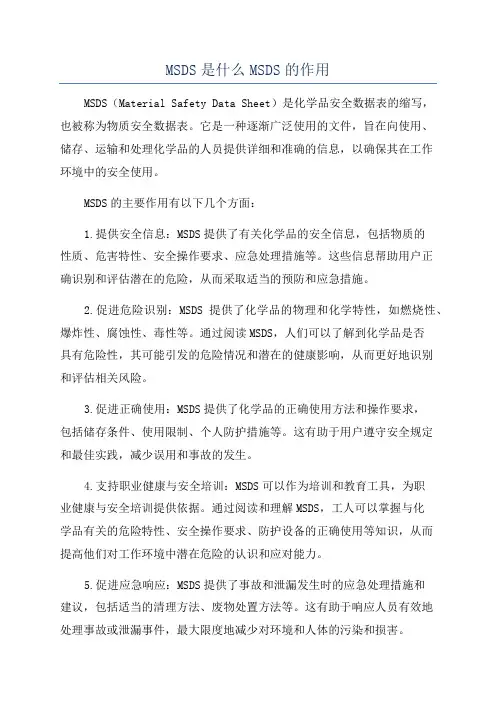
MSDS是什么MSDS的作用MSDS(Material Safety Data Sheet)是化学品安全数据表的缩写,也被称为物质安全数据表。
它是一种逐渐广泛使用的文件,旨在向使用、储存、运输和处理化学品的人员提供详细和准确的信息,以确保其在工作环境中的安全使用。
MSDS的主要作用有以下几个方面:1.提供安全信息:MSDS提供了有关化学品的安全信息,包括物质的性质、危害特性、安全操作要求、应急处理措施等。
这些信息帮助用户正确识别和评估潜在的危险,从而采取适当的预防和应急措施。
2.促进危险识别:MSDS提供了化学品的物理和化学特性,如燃烧性、爆炸性、腐蚀性、毒性等。
通过阅读MSDS,人们可以了解到化学品是否具有危险性,其可能引发的危险情况和潜在的健康影响,从而更好地识别和评估相关风险。
3.促进正确使用:MSDS提供了化学品的正确使用方法和操作要求,包括储存条件、使用限制、个人防护措施等。
这有助于用户遵守安全规定和最佳实践,减少误用和事故的发生。
4.支持职业健康与安全培训:MSDS可以作为培训和教育工具,为职业健康与安全培训提供依据。
通过阅读和理解MSDS,工人可以掌握与化学品有关的危险特性、安全操作要求、防护设备的正确使用等知识,从而提高他们对工作环境中潜在危险的认识和应对能力。
5.促进应急响应:MSDS提供了事故和泄漏发生时的应急处理措施和建议,包括适当的清理方法、废物处置方法等。
这有助于响应人员有效地处理事故或泄漏事件,最大限度地减少对环境和人体的污染和损害。
总结起来,MSDS对于化学品的安全使用至关重要。
通过提供详细和准确的信息,MSDS帮助用户识别潜在的危险,采取适当的预防和应急措施,并确保工作环境中的化学品得到安全管理和处理。
因此,在使用、储存、运输和处理化学品时,阅读和遵守MSDS中的指导和要求是至关重要的。
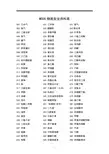
MSDS物质安全资料表001 乙炔气002 氧气003 二氧化碳004 氢气005 氩气006 甲烷007 四氢噻吩008 活性炭009 三乙胺010 硫代磷酰氯011 硫黄012 甲胺磷013 多聚甲醛014 甲缩醛015 黄磷016 氯017 三氯化磷018 甲醇019 液碱020 氨水021 硫酸二甲酯022 甲胺磷023 液氨024 氯仿025 二氯乙烷026 二硫化碳027 甲苯028 盐酸029 氯甲烷030 硫酸031 二甲苯032 醋酸酐033 多聚甲醛034 草甘膦035 稻瘟灵036 异丙胺037 漂白粉038 氯化氢039 氰化氢040 氰化钠041 氯乙酸042 甲缩醛043 丙烯腈044 氧化亚铜045 四氯化锡046 四氧化三铅047 三氯化铝(无水)048 松香水049 红丹油性防锈漆050 酚醛树脂051 硫磺粉(补充)052 一乙胺053三聚氯氰054 三氯乙烯055 磷酸056 四丁基锡057 柴油058 对氨基苯酚059 醋酸乙酯060 对氯硝基苯061 氮气062莠去津063 扑草净064 八氯二丙醚065 硫化钠066 异丙醇067 丙酮068 二氯丙烷069 环己酮070 乙酸异戊酯071 锌粉072 乙醇073 次氯酸钠溶液074 石脑油075 双环戊二烯076 乙酸丁酯077 双氧水078 丙烯酸丁酯079 丙烯酸080 苯乙烯081 过硫酸铵082 过硫酸钾083 丙烯酰胺084 甲醛085 甲基丙烯酸甲酯086 甲基丙烯酸087 汽油088 乙酸089 丙烯酸树脂090 丙烯酸清漆091 丙烯酸漆稀释剂092 丙烯酸磁漆093 二乙醇胺094 煤油095 漂白粉096 漂粉精097 三氯异氰尿酸098 松香099 松节油100 硫化钠101 保险粉102 7385聚氨酯清漆(分装)103 甲酸104 乙酸乙二醇乙醚105 H-3聚氨酯漆固化剂106 聚氨酯漆稀释剂107 263醇酸树脂108 异噻唑啉酮109 N-乙基苯胺110 苯胺111 乙酰甲胺磷112 亚磷酸113 亚磷酸二甲酯114 氯甲烷115 乙醚116 丙烯酸甲酯117 一甲胺118 硝酸镁119 硫化氢120 硫化铵121 一甲胺水溶液122 兔宝宝面漆123 兔宝宝稀释剂124 硫氢化钠125 丙酸126 乙酰氯127 丙酰氯128 丁醇129 醇酸调合漆130 硝酸钠131 溴甲烷132 磷化铝133 正丁醇134 硝基木器漆135 硝化棉(含氮≤12.6%)136 单丁醚137 砷138 碘化汞139 氯化汞140 叠氮化钠141 重铬酸钠142 高锰酸钾143 氰化金钾144 丙烯酸145 甲基丙烯酸甲酯146 苯乙烯147 丙烯酸丁酯148 丁醇149 偶氮二异丁腈150 甲基丙烯酸异丁酯151 甲基丙烯酸(正)丁酯152 乙酰丙酮153 2-丁酮154 生松香155 硫酸铜156 硝酸157 氰化钾158 硝基苯159 氟化钠160 氢氟酸161 蓄电池(注有酸液)162 环氧树脂163 氯苯164 乙苯165 樟脑166 赛璐珞167 氢氧化钾168 乙酸丁酯169 NN-二甲基甲酰胺170 叔丁胺171 氯化亚砜172 碳化钙、电石001 乙炔气标识中文名:乙炔英文名:acetylene分子式:C2H2 分子量:26.04 CAS号:74-86-2 危规号:21024理化性质性状:无色无臭气体,工业品有使人不愉快的大蒜气味溶解性:微溶于水、乙醇,溶于丙酮、氯仿、苯熔点(℃):-81.8(119kpPa)沸点(℃):-83.8 相对密度(水=1):0.62临界温度(℃):35.2 临界压力(MPa):6.14 相对密度(空气=1):0.91燃烧热(KJ/mol):1298.4 最小点火能(mJ):饱和蒸汽压(KPa):4053(16.8℃)燃烧爆炸危险性燃烧性:易燃燃烧分解产物:一氧化碳、二氧化碳闪点(℃):无意义聚合危害:聚合爆炸下限(%):2.1 稳定性:稳定爆炸上限(%):80.0 禁忌物:强氧化剂、强酸、卤素引燃温度(℃):305 最小点火能(mJ):0.02危险特性:极易燃烧爆炸。
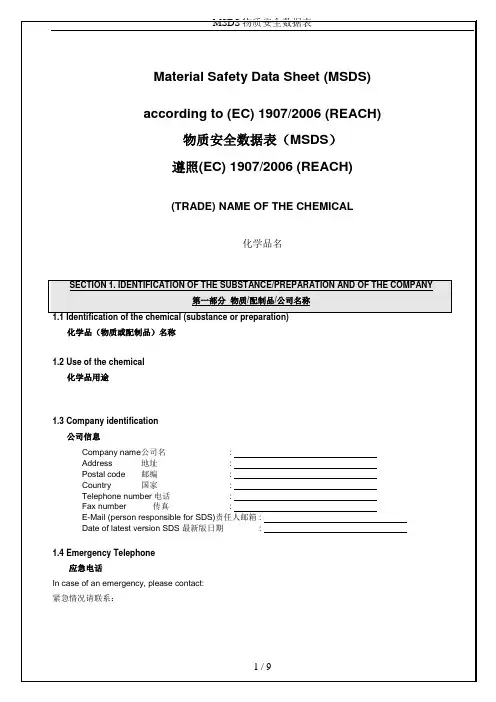



物质安全资料表(MSDS)ER46-09A(油漆、天那水、酒精、松节水、胶水)一、特性:易燃、易爆的液体,遇明火会燃烧,并有激性气味。
具有挥发性。
二、健康危害:油漆(含天那水、二甲苯)对中枢神经系统有麻醉和刺激作用,对眼及上呼吸道有刺激作用,操作人员经常发生皮肤干燥、皲裂、皮炎。
三、急救措施:皮肤接触:脱去被污染的衣着,用肥皂水和清水彻底冲洗皮肤。
眼睛接触:提起眼睑,用流动的清水或生理盐水冲洗、就医。
吸入:迅速脱离现场至空气新鲜处。
保持呼吸道通畅。
如呼吸,可就医,输氧。
如呼吸停止,立即进入人工呼吸,就医。
食入:饮足量温水,催吐,就医。
四、灭火方法:喷水冷却容器,可能的话将容器从火场移至空旷处。
灭火剂、泡沫、二氧化碳、干粉、砂土。
五、泄漏应急处理:迅速撤离泄漏污染区人员至安全区,并进行隔离,严格限制出入。
切断火源。
建议应急处理人员戴防毒面具,尽可能切断泄漏源。
防止进入下水道,排洪沟等限制性空间。
发生泄漏:用纱土或其它不燃材料吸附或吸收或用其构筑围堤,以防大面积泄漏,再用抹布来擦。
并按法规要求交给指定部门处理。
六、储运注意事项:储存于阴凉、通风仓间内。
远离火种、热源。
仓库温度不易超过350C。
防止阳光直射。
保持容器容封。
储存间的开关设在仓外。
配备相应品种和数量的消防器材。
禁止使用易产生火花的机械设备和工具。
灌装时注意流速(不可过快)搬运时要轻装轻卸,防止包装及容器的损坏。
七、防护措施:呼吸系统防护:应急处理时应佩戴防毒面具。
身体防护:戴橡胶手套。
眼睛防护:必要时应戴安全防护眼镜。
其他:工作现场禁止吸烟、进食和饮水。
工作完毕,淋浴更衣。
保持良好的卫生习惯。
批准:编制:日期:2014年6月18日。
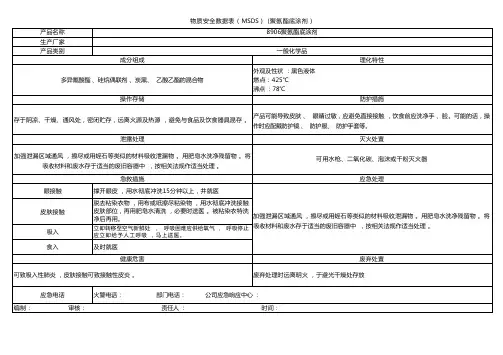
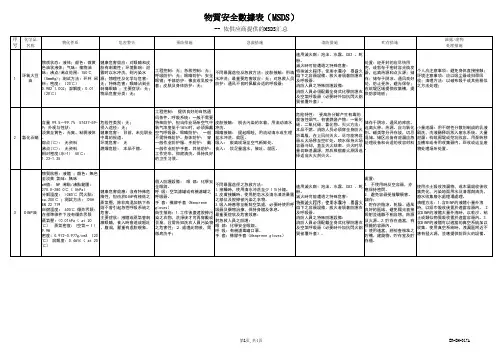
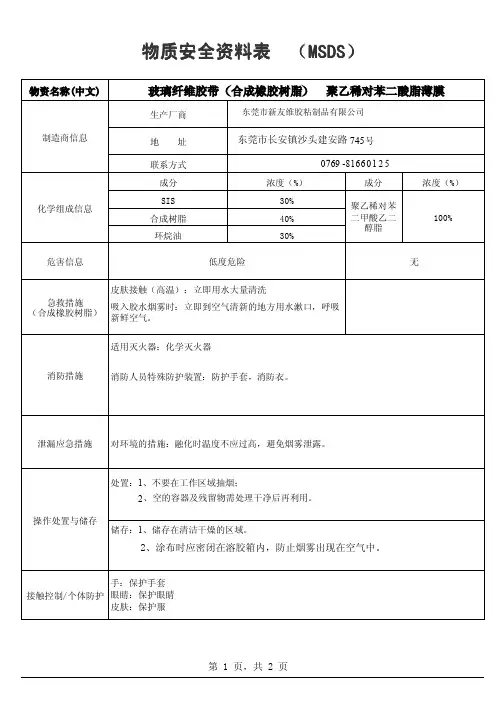
物质安全资料表物质安全资料表 (MSDS MSDS)) 物资名称(中文)玻璃纤维胶带(合成橡胶树脂) 聚乙稀对苯二酸脂薄膜制造商信息生产厂商地 址号联系方式0769-********化学组成信息成分浓度(%)成分浓度(%)SIS 30%聚乙稀对苯二甲酸乙二醇脂100%合成树脂40%环烷油30%危害信息低度危险无急救措施 (合成橡胶树脂)皮肤接触(高温):立即用水大量清洗吸入胶水烟雾时:立即到空气清新的地方用水漱口,呼吸新鲜空气。
消防措施适用灭火器:化学灭火器消防人员特殊防护装置:防护手套,消防衣。
泄漏应急措施 对环境的措施:融化时温度不应过高,避免烟雾泄露。
操作处置与储存处置:1、不要在工作区域抽烟;2、空的容器及残留物需处理干净后再利用。
储存:1、储存在清洁干燥的区域。
2、涂布时应密闭在溶胶箱内,防止烟雾出现在空气中。
接触控制/个体防护手:保护手套眼睛:保护眼睛皮肤:保护服东莞市新友维胶粘制品有限公司东莞市长安镇沙头建安路745物质安全资料表物质安全资料表 (MSDSMSDS))压敏胶理化特性外观:淡黄色透明固体气味:有少量气味稀稠度:高稠度沸点:250℃燃点:280℃-300℃溶解度:溶于甲苯,溶济汽油等。
挥发性:不易挥发稳定性和反应活性稳定性:稳定应避免和挥发性溶济堆放在一起。
毒理学信息无环境生态资料无运输信息避免和挥发性溶剂一起运输废弃物处理方法在可控制的情况下焚烧法规信息根据欧盟EEC88/379指引,本产品无需规范性标签常见使用故障不粘,渗胶注意事项调整胶水配发,提高SIS含量和提高树脂软化点封箱不牢,容易起翘1、封箱后,稍微加力,使胶带与纸箱完全贴合;2、提高胶水的内聚力U-will Adhesive Products Co.,LtdNo.745,JIAN’AN RD,SHATOU,CHANG’AN TOWN,DONGDUAN CITY PROVINCE,CHINATel:0769-********Fax:0769-********E-Mial:*****************。
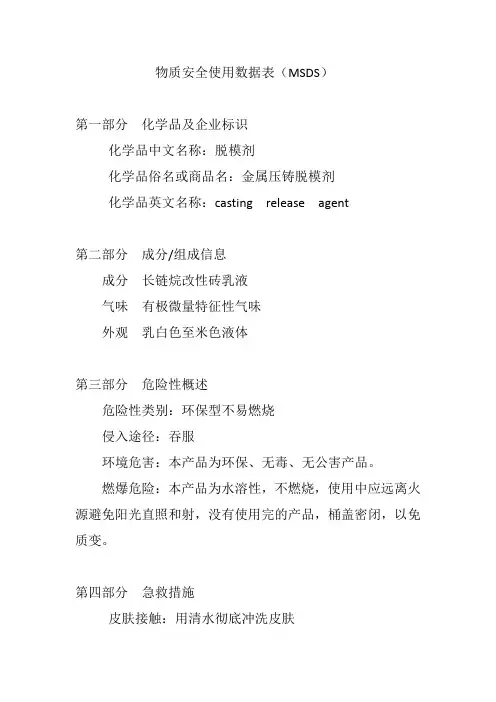
物质安全使用数据表(MSDS)第一部分化学品及企业标识化学品中文名称:脱模剂化学品俗名或商品名:金属压铸脱模剂化学品英文名称:casting release agent第二部分成分/组成信息成分长链烷改性砖乳液气味有极微量特征性气味外观乳白色至米色液体第三部分危险性概述危险性类别:环保型不易燃烧侵入途径:吞服环境危害:本产品为环保、无毒、无公害产品。
燃爆危险:本产品为水溶性,不燃烧,使用中应远离火源避免阳光直照和射,没有使用完的产品,桶盖密闭,以免质变。
第四部分急救措施皮肤接触:用清水彻底冲洗皮肤吸入:无特殊反应食入:现时未发现会对健康或生命构成危害。
第五部分消防措施危险特性:不易燃烧有害燃烧产物:CO2灭火方法及灭火剂:可用泡沫,二氧化碳、干粉、沙石扑救、用水灭火效。
第六部分泄露应急处理应急处理:大量物质溢漏应有容器收集后并弃置,小量物质溢漏时,如果当地法规允许,将其冲入下水道。
废物弃置方法:第七部分操作处置与储存操作注意事项:防止阳光长时间暴晒。
储存注意事项:储存于阴凉,通风库房仓、仓库温度宜5一45℃,保持容器密封,应与氧化剂、食用化学品分开存放,切忌混储。
第八部分接触控制/个体防护工程控制:加强通风。
呼吸系统防护:无害物质,无需特别防护。
眼睛防护:无害物质、无需特别防护。
身体防护:无害物质,无需特别防护。
手防护:无害物质,无需特别防护。
其他防护:工作现场禁止吸烟。
第九部分理化特性外观与性状:乳白色至米色液体粘度性:600一1200cps/25℃。
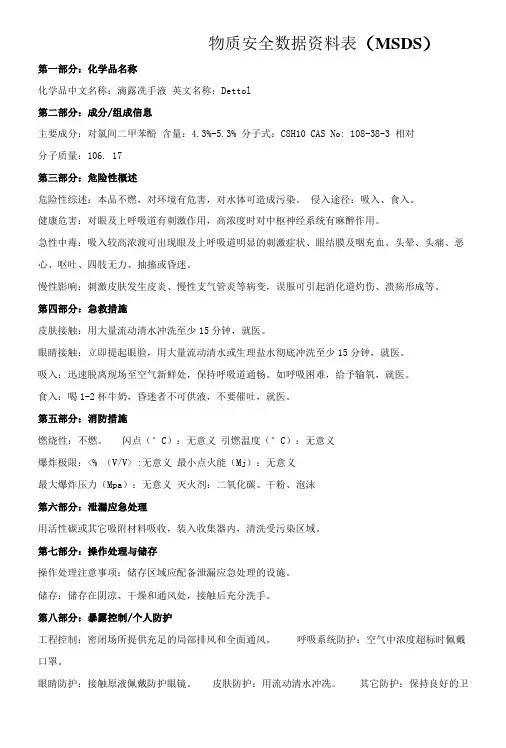
物质安全数据资料表(MSDS)第一部分:化学品名称化学品中文名称:滴露冼手液英文名称:Dettol第二部分:成分/组成信息主要成分:对氯间二甲苯酚含量:4.3%-5.3% 分子式:C8H10 CAS No: 108-38-3 相对分子质量:106. 17第三部分:危险性概述危险性综述:本品不燃,对环境有危害,对水体可造成污染。
侵入途径:吸入、食入。
健康危害:对眼及上呼吸道有刺激作用,高浓度时对中枢神经系统有麻醉作用。
急性中毒:吸入较高浓渡可出现眼及上呼吸道明显的刺激症状、眼结膜及咽充血、头晕、头痛、恶心、呕吐、四肢无力、抽搐或昏迷。
慢性影响:刺激皮肤发生皮炎、慢性支气管炎等病变,误服可引起消化道灼伤、溃疡形成等。
第四部分:急救措施皮肤接触:用大量流动清水冲洗至少15分钟,就医。
眼睛接触:立即提起眼脸,用大量流动清水或生理盐水彻底冲洗至少15分钟,就医。
吸入:迅速脱离现场至空气新鲜处,保持呼吸道通畅。
如呼吸困难,给予输氧,就医。
食入:喝1-2杯牛奶,昏迷者不可供液,不要催吐,就医。
第五部分:消防措施燃烧性:不燃。
闪点(°C):无意义引燃温度(°C):无意义爆炸极限:<% (V/V> :无意义最小点火能(Mj):无意义最大爆炸压力(Mpa):无意义灭火剂:二氧化碳、干粉、泡沫第六部分:泄漏应急处理用活性碳或其它吸附材料吸收,装入收集器内,清洗受污染区域。
第七部分:操作处理与储存操作处理注意事项:储存区域应配备泄漏应急处理的设施。
储存:储存在阴凉、干燥和通风处,接触后充分洗手。
第八部分:暴露控制/个人防护工程控制:密闭场所提供充足的局部排风和全面通风。
呼吸系统防护:空气中浓度超标时佩戴口罩。
眼睛防护:接触原液佩戴防护眼镜。
皮肤防护:用流动清水冲冼。
其它防护:保持良好的卫生习惯。
第九部分:理化特性外观与性状:无色或微黄色液体,有刺鼻气味。
熔点(笆):-47.9相对密度(水= 1): 0. 86 沸点(°C):无意义饱和蒸汽压(Kpa):无意义燃烧热(Kj/Mol):无意义临界温度(°C):无意义临界压力:无意义溶解性:与水混溶,溶于碱液。
化学物质安全数据表(MSDS 清单)序号1 2 3 4 5 6 7 8 9 10 11 12 13 14 15化学品名称苯甲苯二甲苯乙醚四氯化碳甲醇乙醇丁醇硝酸丙酮苯酚甲醛甲醛氢氧化钠三氯甲烷主要物质成份C H6 6C H7 8C H8 10C H O4 10CCl4CH3OHC H OH2 5C H OH4 9HNO3C H O3 6C H O6 6CH O2CH O2NaOHCHCl3理化性质无色有芳香气味的液体,易燃烧,难溶于水,易溶于有机溶剂,蒸汽有毒无色透明有特殊芳香味的液体,不溶于水,溶于乙醇等溶剂无色易燃透明液体,不溶于水,溶于乙醇等溶剂无色透明液体,易挥发,有吸湿性,味甜无色液体,有特殊甜味,微溶于水不易燃无色透明易燃液体,有毒无色透明易挥发液体,易溶于水无色有酒味的液体,微溶于水带微黄色液体,有强烈刺激腐蚀性无色透明略带香味的液体,易着火,与水、乙醇互溶白色晶体,有臭味,有毒,有腐蚀性,易溶于酒精无色有刺激性的气体,有毒,溶于水,溶于乙醇等溶剂无色有刺激性的气体,易聚合,有还原性白色半透明晶状固体,有强吸湿性,溶于水无色透明易挥发液体,难溶于水,易溶于有机溶剂,在空气中易被氧化成剧毒光气危害性21,2,72,71、2、77,102,72251,2,773、71、3、5、757,10处理措施密闭储存密闭储存密闭储存密封存于阴凉、干燥处密闭储存密闭储存密闭储存密闭储存密闭保存,避光密闭储存密闭储存密闭储存密闭储存密闭储存用自来水冲洗密闭储存注:危害性:(1) 爆炸性(2)易燃性(3) 可燃性(4)自燃性(5)腐蚀刺激性(6) 急性毒性(7)特定毒性(8) 破坏臭氧层物质(9)氧化性(10)有机氯溶剂化学物质安全数据表(MSDS 清单)序号 化学品名称 16 甲酸 17 氨水 18 对苯二酚 19 四氢呋喃 20 碘化钾 21 硫代硫酸钠 22 溴水 23 磷酸 24 次氯酸钠25 碳酸氢钠 26 亚硝酸钠 27 碳酸铵 28 新洁尔灭 29 氯化锌 30 氢氧化钠溶液主要物质成份 HCOOH NH ·H 0 C H O 6 6 2C H O 4 8KINa S O 2 2 3Br 2H PO 3 4NaClONaHCO 3NaNO 2(NH 4)2CO 3 苯扎溴铵 ZnCl 2NaOH理 化 性 质有强腐蚀性和辛辣刺激性酸味的挥发性液体无色、有强烈刺激性气味气体无色固体,溶于水无色液体,有醚样气味,能与水,醇、醚、酮、酯、烃类混合无色或者白色立方晶体,无臭,有浓苦咸味,溶于水无色透明晶体,溶于水 暗红棕色液体,能溶于水 不稳定无色晶体,易潮解,易溶于水淡黄色透明液体,呈碱性,强氧化剂白色结晶或者粉末,溶于水,不溶于乙醇 白色或者微黄色斜方晶体,易吸湿 无色晶体或者白色粉末, 具有强烈氨臭 淡黄色胶状体, 嗅芳香,味苦,易溶于水白色固体,易潮解, 极易溶于乙醚无色液体危害性55727 无 5、9 55 无 1,3,、9 无 无 无 5处 理 措 施 用自来水冲洗 密闭储存 密闭储存 密封存放,远离火种 密封避光存放 密闭保存 密闭保存 密闭储存 用自来水冲洗 密闭保存 密闭保存 密闭保存 密封保存 密封保存 用自来水冲洗注: 危害性:(1)爆炸性 (2) 易燃性 (3)可燃性 (4) 自燃性 (5) 腐蚀刺激性 (6)急性毒性 (7)特定毒性 (8)破坏臭氧层物质 (9) 氧化性 (10) 有机氯溶剂化学物质安全数据表(MSDS 清单)理 化 性 质 主要物质成份 处 理 措 施化学品名称 危害性 序号 3 2 5313233343536373839404142434445锌粉氢氧化钾硫酸 冰醋酸 无水碳酸钠活性炭硫化钠 酚酞 氯化钾次甲基兰 硫氰酸钾硝酸银 聚乙二醇 2000柠檬酸铵邻苯二甲酸二乙酯ZnKOHH 2SO 4 CH COOH 3Na CO 2 3CNa S 2C H O4 20 14KCLC 16H 18N 3SCl .3H 2OKSCNAgNO 3C H N O 6 17 3 7C H O 12 14 4浅灰色粉末,有强还原性,易燃白色吸湿性固体 无色透明油状液体 无色液体,有刺激性酸味 无色粉末,热稳定性高 有多孔结构的颗粒,有吸附作用无色结晶,易潮解释放 H 2S 气体,有毒白色粉末,溶于乙醇 白色晶体粉末 兰绿色粉末状固体无色单斜晶系结晶,易溶于水、乙醇、丙酮等无色透明斜方晶体,有机物存在时变黑,在纯净空气中,露光不变色无色粘稠液体白色晶体粉末,易潮解,溶于水无色液体,微具芳香味,不溶于水,溶于苯、丙酮等255、9 5、7 无 无7 无 无775,7,9 无 无 无密封保存 密封保存密封保存,自来水冲洗密封保存 密封保存 密闭保存 密闭保存 密闭保存 密闭保存 棕色瓶保存密封存于阴凉、干燥处密封存放 密封存放 密封存放 密封存放注:危害性:(1)爆炸性 (2) 易燃性 (3)可燃性 (4) 自燃性 (5)腐蚀刺激性 (6)急性毒性 (7)特定毒性 (8)破坏臭氧层物质(9) 氧化性 (10) 有机氯溶剂化学物质安全数据表(MSDS 清单)理 化 性 质 无色粘稠液体。
物质安全资料表(MSDS)Chemicals MSDS去污水主要危害成分:乙醇,丙酮危害警告讯息:1.可燃性液体。
2.入眼会刺激粘膜,对皮肤有刺激性,吸入时会引起喉咙炎症、支气管炎、肺炎、肺气肿等损伤,吞入有危害。
危害防范措施:1.远离热源,严禁烟火,储存在房间阴凉处。
2.强制排风,穿戴适当的防护器具。
3.避免直接接触,一旦误触,立即用大量清水冲洗相关部位,并就医。
应急处理 1.使用干粉、二氧化碳、泡沫灭火器灭火。
2.使用黄沙或棉布等进行泄露处理,禁止使用易产生火星的工具,并佩带个人防护器具。
废弃处理1.废液不得倒入下水道、地面或任何水体,所有废液和沾有该物质的物件都应收集。
2.委托合格的供应商进行废弃处理。
更详细的资料请参考物质安全资料表Chemicals MSDS乙醇主要危害成分:*****H 危害警告讯息:1.易燃,其蒸汽与空气可形成爆炸性混合物,遇明火、高热能引起燃烧爆炸。
2.与氧化剂接触发生化学反应或引起燃烧。
3.在火场中,受热的容器有爆炸危险。
4.其蒸汽比空气重,能在较低处扩散到相当远的地方,遇明火会引起回燃。
危害防范措施:1.储存于阴凉、通风的仓间内,远离火种、热源,温度不宜超过30℃,防止阳光直射,保持容器密封。
2.应与氧化剂分开存放,使用防爆型通风、照明设施,工作时穿戴适当的防护器具。
3.禁止使用易产生火花的机械设备和工具,接地,防止静电积聚。
应急处理 1.使用干粉、二氧化碳、泡沫灭火器灭火。
2.使用黄沙或棉布等进行泄露处理,禁止使用易产生火星的工具,并佩带个人防护器具。
废弃处理 1.废液不得倒入下水道、地面或任何水体,所有废液和沾有该物质的物件都应收集。
2.委托合格的供应商进行废弃处理。
Chemicals MSDS异丙醇主要危害成分:C3H8O 危害警告讯息:1.易燃,其蒸气与空气可形成爆炸性混合物,遇明火、高热能引起燃烧爆炸。
2.与氧化剂接触会猛烈反应,在火场中,受热的容器有爆炸危险。
物料安全数据表的简称物料安全数据表(MSDS)是指一份详细记录物质性质、危害性、安全操作方法、应急措施等信息的文件。
MSDS是各种化学品、材料、制品等生产、销售、运输和使用环节中的必备文件,旨在保障人类安全以及环境保护。
本文将从MSDS的定义、作用、编写方法、使用方法等方面进行阐述。
一、MSDS的定义MSDS是物料安全数据表的简称,是一份详细记录物质性质、危害性、安全操作方法、应急措施等信息的文件。
它是各种化学品、材料、制品等生产、销售、运输和使用环节中的必备文件,旨在保障人类安全以及环境保护。
二、MSDS的作用1.保障人员安全MSDS记录了物质的性质、危害性、安全操作方法、应急措施等信息,提供了使用者和处理者所需的安全信息,使其能够更好地进行安全操作和应急处理,从而保障人员的安全。
2.保护环境MSDS记录了物质的环境影响信息,包括物质对大气、水、土壤等环境的影响以及处理方法等,使得使用者和处理者能够更好地进行物质管理,减少对环境的影响。
3.促进贸易MSDS是各种化学品、材料、制品等生产、销售、运输和使用环节中的必备文件,可以促进贸易合作,保障贸易安全。
三、MSDS的编写方法1.信息的收集MSDS的编写需要收集物质的性质、危害性、安全操作方法、应急措施等信息。
这些信息可以通过物质的生产厂家、供应商、研究资料、相关法规等途径获取。
2.信息的整理收集到的信息需要进行整理,以确保信息的准确性、完整性和可读性。
整理后的信息应该按照一定的结构进行编排。
3.信息的编排MSDS的编排需要按照一定的结构进行,包括物质的标识、物质的成分、物质的危害性、物质的安全操作方法、应急措施等。
信息的编排需要符合相关法规和标准。
4.信息的更新MSDS需要随着物质的性质、危害性、安全操作方法、应急措施等信息的变化不断进行更新,以确保信息的准确性和完整性。
四、MSDS的使用方法1.存档备查MSDS需要存档备查,以便在需要时进行查询和使用。
MSDS是什么意思很多企业在贸易过程中会被客户要求提供MSDS报告,不少企业连MSDS是什么意思也不清楚。
那么,MSDS是什么意思呢?MSDS是什么意思MSDS是英文Material Safety Data Sheet的缩写,一般直译为材料安全数据表,正式中文名称是化学品安全说明书。
美国、加拿大、澳洲及亚洲多国一般称MSDS,而ISO、欧洲及中国称为SDS(Safety Data sheet,安全数据表)。
MSDS的作用MSDS是在贸易过程中,化学品生产商或销售商向客户提供的一份详细的物质或混合物的理化参数、燃爆性能、毒性和环境危害以及安全使用、泄漏应急救护处置、法律法规等方面信息的综合性说明文件,以帮助该物质或混合物的使用者更好的控制风险。
MSDS包含哪些内容根据不同国家法律要求,MSDS内容不一样,欧盟、ISO、美国OSHA、ANSI、中国要求MSDS(SDS)包含16项:•第一项:化学品名称和制造商信息•第二项:化学组成信息•第三项:危害信息•第四项:急救措施•第五项:消防措施•第六项:泄露应急处理•第七项:操作和储存•第八项:接触控制和个人防护措施•第九项:理化特性•第十项:稳定性和反应活性•第十一项:毒理学信息•第十二项:生态学信息•第十三项:废弃处置•第十四项:运输信息•第十五项:法规信息•第十六项:其他信息加拿大要求MSDS内容则为9项:产品名称和制造商信息、危险化学品组分、物理特性、消防或燃爆数据、反应活性数据、毒理学特性、预防措施、急救方法、编制信息。
MSDS法律依据•联合国:GHS(化学品统一分类和标签制度);•欧盟:REACH法规、CLP法规;•美国:ANSI Z400.1-2004、有毒物质控制法案(TSCA)、危险物品运输法等;•日本:日本劳动安全卫生法、毒物及剧物取缔法、化学物質排出把握管理促進法等;•中国:危险化学品安全管理条例、危险化学品登记管理办法、化学品分类和危险性公示通则、化学品安全技术说明书编写规定等。
bkMATERLAL SAFETY DATA SHEETB&K Testing center Issue date:2008-8-01 Rev:2008-001LI-ION(LiCoO2) RECHARGEABLE BATTERY1.PRODUCT.IDENTIFEICATIONProduct: RechargeableTrade name: LI-ION(LiCoO2)Model: 473442AR(T-100)/ 550mAhElectrochemical system:Electrodes: Negative Electrode: CPositive Electrode: LiCoO2Electrolyte: LiPF6Nominal Voltage: 3.7 V oltPOSITION.No More Than Lithium Is Contained3.HAXARD DATA3.1 Physical:The Li-ion batteries described in this Material Safety Data Sheet are sealed which are not hazardous when used according to the recommendations of the manufacturer.Under normal conditions of use, electrode materials and liquid electrolyte they contain are non-reactive provided the battery integrity is maintained and seals remain intact, Risk of exposure only in case of abuse, e.g. mechanical, thermal, electrical, which leads to the activation of safety valves and/or the rupture of the battery containers. Electrolyte leakage, electrode materials reaction with moisture/water of battery vent/explosion/fire may follow depending upon circumstances.3.2Chemical:1. Name of Special Risks:R14/15 Reacts with water and yields flammable gasesR21 Harmful in contact with skinR22 Harmful us swallowedR35 Causes severe burnsR41 Risk of serious damage to the eyeR42/43 May cause sensitization by inhalation and skin contactR43 May cause sensitization by skin contact2. Safety Advices:S2 Keep out of reach from childrenS8 Keep away from moistureS22 Do not breathe dustS24 Avoid contact with skinS26 In case of contact with eyes, rinse immediately with plenty of water and seek medical attention S36 Wear suitable protective clothingS37 Wear suitable glovesS45 In case of incident, seek medical attention4.First Aid MeasuresIn case of battery rupture or explosion, evacuate personnel from contaminated area and provide maximum ventilation to clear out corrosive fumes/gases and pungent odors.In all case,seek immediate medical attention,Eye contact: Flush with plenty of water(eyelids-held open)for at least 15 minutesSkin contact: Remove all contaminated clothing and flush affected areas with plenty ofwater and sop for at least 15minutes.Ingestion: Dilute by giving plenty of water and get immediate medical attention.Assure that the victim does not aspirate vomited material by use of positionaldrainage.Assure that mucus does not obstruct the airway.Do not give anything by mouth to an unconscious personInhalation: Remove to fresh air and ventilate the contaminated area.Give oxygen or artificial respiration if needed.6.Accidental Release MeasuresThe material contained within the batteries would only be expelled under abusive conditions. Using shovel or broom, cover battery or spilled substances with dry sand or vermiculite, place in approved container (after cooling if necessary) and dispose in accordance with local regulations.7.Hahdling and StorageThe batteries should not be opened destroyed nor incinerated since they may leak or rupture and release in the environment the ingredients they contain.9.1 Appearance (Physical shape and color as supplied:)Metal squares, hermetically sealed and fitted with an external plastic box.9.4 Specific pulse power : ≈ 300 Wh/kg9.5 Mechanical resistance : As defined in relevant IEC standard11.Toxilogical InformationThe Li-ion batteries do not contain toxic materials 12 Ecological InformationWhen properly used or disposed, the Li-ion batteries do not resent environmental hazard 13.Disposal ConsiderationsDispose in accordance with applicable regulations which vary from country to country.(In more countries, the thrashing of used batteries is forbidden and the end-users are invited to dispose them properly, eventually through not-for-profit organizations, mandated by local governments or organized on a voluntary basis by professionals). Lithium-Ion batteries should have their terminals insulated and be preferably wrapped in plastic bags prior to disposal. 13.1 Incineration : Incineration should never be performed by battery users but eventually bytrained professionals in authorized facilities with proper gas and fumes treatment. 13.2 Land filling : Leach ability regulations (mg/l) 13.3 Recycling : Send to authorized recycling facilities, eventually through licensed waste carrier.14. TRANSPORT INFORMATIONThe battery models listed have aggregate equivalent lithium content below the 8g. And shipment contains no item listed under IA TA DGR Special Provision A154 ,and meets all requirements under UN Manual of Tests and Criteria Part III, subsection 38.3.The product is not classified as dangerous under the current edition of the ICAO & IA TA dangerous goods regulations and according A45 all applicable Carriers. The product is safe for air transportation and not regulated by ICAO & IA TA DGR.15.REGULATORY INFORMATIONThe transport of rechargeable lithium-ion batteries is regulated by various bodies (IATA, IMO, ADR,US-DOT) that follow the United Nations "Recommendations on the Transport of Dangerous Goods, Model Regulations, 15th Revised edition - Ref.ST/SG/AC.10/1 Rev. 15".Depending on their lithium metal equivalent weight content, design, and ability to pass safety testsdefined by the UN in the "Recommendations on the Transport of Dangerous Good - Manual of Tests and Criteria – 4th Revised edition - Ref. ST/SG/AC.10/11 Rev.4 Amendment 1 «Lithium Batteries»", thelithium-ion cells and the battery packs are not be assigned to the UN N° 3090 Class-9, that is restricted for transport.Individual lithium-ion cells and battery packs with respectively less than 1.5 and 8 grams of equivalent lithium metal content that pass the UN-defined safety tests, are not restricted for transport (1.0 Ah of declared nominal capacity = 0.3 gram of Li equivalent weight content).Shipment contains no item listed under IATA DGR special provision A154 and it meets all thereoutbents of SP A45 including the passing the UN38.3 test.16,Other Information/DisclaimerThis information has been compiled from sources considered to be dependable and is, to the best of our knowledge and belief, accurate and reliable as of the date compiled. However, no representation, warranty (either expressed or implied) or guarantee is made to the accuracy, reliability or completeness of the information contained herein.This information relates to the specific materials designated and may not be valid for such material used in combination with any other materials or in any process. It is the user's responsibility to satisfy himself as to the suitability and completeness of this information for his particular use.B&K does not accept liability for any loss or damage that may occur, whether direct, indirect, incidental or consequential, from the use of this information. B&K does not offer warranty against patentinfringement. Additional information is available by calling the telephone number above designatedpurpose.。